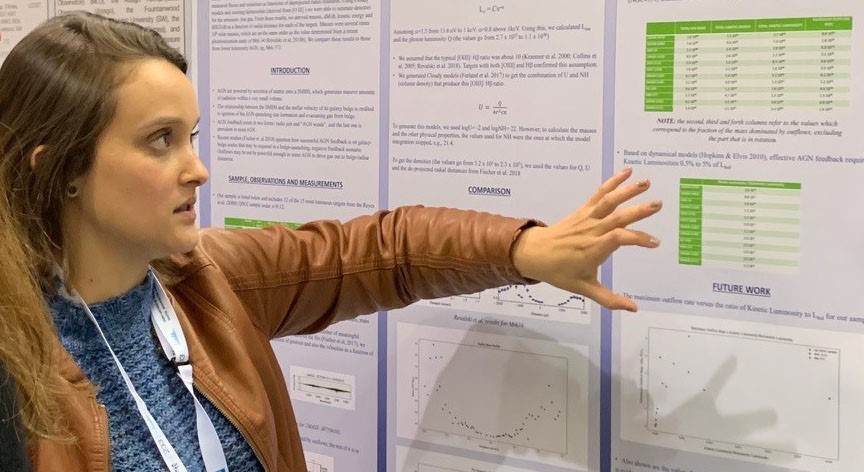Tracking X-ray Outflows with Optical Footprints
Anna Trindade Falcão
The Catholic University of America
Graduate Student
Physics Department, The Catholic University of America
Wed, September 22, 2020 - 4:00 PM
Karl Herzfeld Auditorium of Hannan Hall - Rm 108
 The Supermassive black holes (SMBH) can be found within the center of all massive galaxies. A small percentage of these are actively accreting mass from the surrounding accretion disk, which we define as active galactic nuclei (AGN). This accretion is the result of mass inflows to the central SMBH that can be triggered both from outside the galaxy, via interactions with companions, or from inside it, via secular processes. The process of fueling the AGN and the subsequent feedback are widely acknowledged to play a critical role in the evolution of galaxies by expelling gas from the central regions of galaxies, shutting down their global star formation, and regulating their stellar mass and size growth. AGN feedback certainly exists in two forms: powerful jets, which are highly collimated but occur in only 5-10% of the AGN population, and winds. AGN winds are frequently observed as UV and Xray absorption lines blueshifted with respect to their host galaxies, originating in gas within tens to hundreds of parsecs from the central SMBH, or emission-line gas in AGN narrow-line re- gions. Recent studies question how effective AGN feedback is on galactic-bulge scales, as required in a star-formation quenching, negative feedback scenario. Therefore it is important to quantify its impact, which can be accomplished by characterising the physical properties of these outflows, such as mass, velocity, mass outflow rate, and kinetic energy.
The Supermassive black holes (SMBH) can be found within the center of all massive galaxies. A small percentage of these are actively accreting mass from the surrounding accretion disk, which we define as active galactic nuclei (AGN). This accretion is the result of mass inflows to the central SMBH that can be triggered both from outside the galaxy, via interactions with companions, or from inside it, via secular processes. The process of fueling the AGN and the subsequent feedback are widely acknowledged to play a critical role in the evolution of galaxies by expelling gas from the central regions of galaxies, shutting down their global star formation, and regulating their stellar mass and size growth. AGN feedback certainly exists in two forms: powerful jets, which are highly collimated but occur in only 5-10% of the AGN population, and winds. AGN winds are frequently observed as UV and Xray absorption lines blueshifted with respect to their host galaxies, originating in gas within tens to hundreds of parsecs from the central SMBH, or emission-line gas in AGN narrow-line re- gions. Recent studies question how effective AGN feedback is on galactic-bulge scales, as required in a star-formation quenching, negative feedback scenario. Therefore it is important to quantify its impact, which can be accomplished by characterising the physical properties of these outflows, such as mass, velocity, mass outflow rate, and kinetic energy.
We use Hubble Space Telescope (HST )/ Space Telescope Imaging Spec- trograph (STIS) long-slit G430M and G750M spectra to analyze the extended [O III] λ5007 emission in a sample of twelve nearby luminous QSO2s. The purpose of the study is to determine the properties of the mass outflows of ion- ized gas and their role in AGN feedback. We measure fluxes and velocities as functions of radial distances. Using Cloudy models and ionizing luminosities de- rived from [O III], we are able to estimate the densities for the emission-line gas. From these results, we derive masses of [O III]-emitting gas, mass outflow rates, kinetic energies, kinetic luminosities, momenta, and momentum flow rates as a function of radial distance for each of the targets. For the sample, masses are several times 103 M0 - 107 M0 and peak outflow rates are 9.3 × 10−3 M0 yr−1 to 10.3 M0 yr−1. The peak kinetic luminosities are 3.4 10−8 to 4.9 10−4 of the bolometric luminosity, which does not approach the 5.0 10−3 - 5.0 10−2 range required by some models for efficient feedback. In addition, three targets show extended [O III] emission, but compact outflow regions. This may be due to different mass profiles or different evolutionary histories.
Refreshments served at 3:45 PM
If you have any questions about the Colloquium Series or would like to make a donation please contact the Physics Department, cua-physics@cua.edu or (202) 319-5315.
